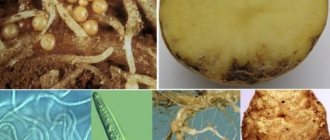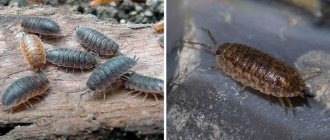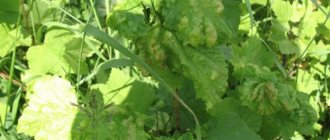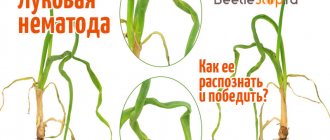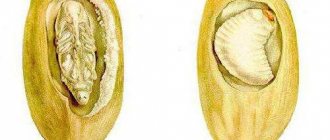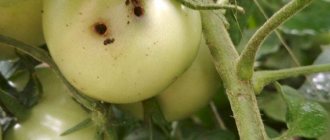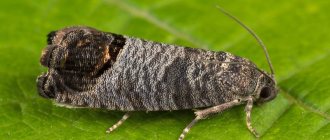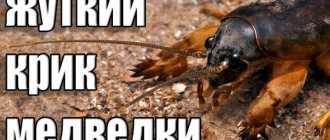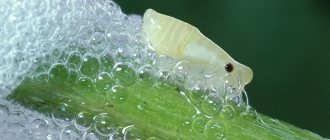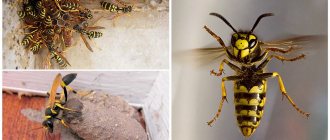Nematode
The species community of nematodes - small roundworms - is diverse. Scientists have described more than 24,000 species, but tens of times more have not been studied. These microscopic worms can be both beneficial - they live in soil, water and are an important part of the ecosystem, and harm - they parasitize plants, animals and humans.
Difficulties in exterminating the pest
The extermination of pests is made difficult by their localization in the soil. Moreover, the peak of nematode activity occurs during the growing season, when it is impossible to treat the soil under plants with chemicals, and replanting is undesirable.
The main fight against them takes place in autumn and spring; removing a colony can take several years.
In the case of the most vulnerable crops, success is considered to be containing the population size, which does not allow it to reach a level of high harmfulness.
What kind of pest is this and what diseases does it cause?
Root-knot nematodes are dangerous parasites of the root system. This is the family of roundworms Meloidogynidae, pests of more than 3,000 species of monocotyledonous and dicotyledonous plants, cultivated and wild grasses, shrubs and trees.
Five species of nematodes have been recorded in Russia, only two of which are found outside shelters.
They most intensively parasitize:
- cucumbers;
- tomatoes;
- eggplants;
- potatoes;
- salad;
- celery;
- carrots;
- ornamental plants.
Worms affect:
- chrysanthemums;
- begonias;
- clematis;
- peonies;
- carnations;
- calendula;
- gerberas.
Among fruit crops, mainly shrubs such as currants or gooseberries, which can be grown in a greenhouse, are affected.
In open plantings in Russia, the nematode is dangerous only for vegetable and flower plants.
A common feature of all root nematodes is that they penetrate the root parenchyma in the growth zone and, by secreting enzymes, provoke disturbances in cell division.
In the plant tissues around the worm, a structure of giant cells is formed, the components of which have abnormal sizes, shapes and chemical compositions. These formations provide food for the pest.
The plant reacts to damage by surrounding the deformed area with a growth - a gall.
The ability of the root to absorb water and nutrients is reduced, the diseased plant withers, stops growing, blooms poorly and produces few fruits.
List of known hosts [3] [1] [edit]
- Actinidia chinensis (Chinese gooseberry)
- Ageratina adenophora (Croftonweed)
- Allium cepa (onion)
- Ananas comosus (pineapple)
- Anemone (anemone)
- Apium graveolens (celery)
- Arachis hypogaea (peanut)
- Beta
- Beta vulgaris var. saccharifera (sugar beet)
- Brassica napus var. napus (rape)
- Brassica oleracea var. capitata (cabbage)
- Cajanus cajan (pigeon pea)
- Camellia sinensis (tea)
- Capsicum annuum (bell pepper)
- Carica papaya (papaya)
- Chenopodium album (fat chicken)
- Chenopodium quinoa (quinoa)
- Chrysanthemum (chamomile)
- Cichorium intybus (chicory)
- Coffea (coffee)
- Convolvulus arvensis (convolvulus)
- Kukumis (melons, cucumbers, gherkins)
- Cyclamen
- Daucus carota (carrot)
- Dianthus caryophyllus (clove)
- Dioscorea batatas (Chinese yam)
- Eustoma grandiflora (lisianthus (cut flower crop))
- Fabaceae (grain legumes)
- Fragaria ananassa (strawberry)
- Glycine max (soybeans)
- Lactuca sativa (lettuce)
- Linum usitatissimum (flax)
- Medicago sativa (alfalfa)
- Menta (mint)
- Nicotiana tabacum (tobacco)
- Olea europaea subsp. europaea (European olives)
- Pelargoniums (pelargoniums)
- Phaseolus (bean)
- Raphanus sativus (radish)
- Rose (roses)
- Rubus (blackberry, raspberry)
- Sinapis alba (white mustard)
- Solanum (nightshade)
- Solanum lycopersicum (tomato)
- Solanum melongena (eggplant)
- Solanum nigrum (black nightshade)
- Solanum tuberosum (potato)
- Tanacetum cinerariifolium (Feverfew)
- Trifolium (clover)
- Vicia
- Vitis vinifera (grapevine)
- Zingiber officinale (ginger)
What it looks like (morphology)
Root nematodes are very small white worms. The body length of the largest representatives of the family does not exceed 2.5 mm. The smallest species grow up to 0.3-0.4 mm.
The color is clear or with a pearly, silvery tint. In the area of the oral cavity, a stylet is formed on the head of the nematode, which is a hollow needle for piercing plant tissue and absorbing juices. Sex differences are pronounced.
Female body
Oval or spherical in shape, on average 0.6-0.8 mm long, 0.4-0.5 mm in diameter. A characteristic feature that distinguishes Meloidogynidae from other nematodes is the presence of a pattern on the posterior end of the body of females.
The anus and vulva are surrounded by many wavy arches, interrupted by short stripes on the sides.
These prominent grooves do not consist of cells, but are several layers of secretions from the integumentary epithelium.
Male
Longer and thinner, has a worm-shaped body. Different species differ in the shape of their head and tail.
The stylet is well developed, although usually the males do not feed and do not penetrate the plant tissue, living in the root soil.
A male individual may have one or two testes; sperm are transferred through special processes - spicules, which move out of the cloacal opening.
Kinds
Currently, about 100 species of root-knot nematodes are known. The differences in appearance are not significant; the size, shape of individual parts of the body, and the number of testes in males vary. Not all species are capable of sexual reproduction.
Some of them specialize in one type of plant, others are able to attack several families.
For example, cereal, vegetable, cruciferous, ornamental, oilseed, fruit trees and shrubs can be carriers of the Java nematode.
Some types of nematodes are capable of developing in the conditions of most agricultural regions, while others are limited to one climatic zone.
The most common species include Northern, Southern, Columbia, Peanut and False root-knot nematodes.
Northern nematode
This species has two names: Meloidogyne hapla and Meloidogyne marioni. The body length of males is up to 1.5 mm, females - up to 0.6 mm.
Having reached maturity, the worms continue to grow, only the solid organs - the stylet and spicules - remain unchanged.
The eggs are large, their diameter almost coincides with the width of the female’s body. One individual can lay up to 2000 pieces. The eggs can withstand soil freezing down to -30°C. Larvae that have burrowed into the roots of perennial plants also survive frosts successfully.
The pest provokes the formation of spherical galls on the roots, often small in size.
But sometimes the diameter of the thickenings reaches several centimeters, it depends on the plant and environmental conditions. Typically, many secondary roots grow on the galls.
The northern nematode parasitizes the roots of vegetable and ornamental crops. It lives in areas located between 34 and 43 degrees north and below 45 degrees south latitude.
In Russia it is found both in open ground and in greenhouses.
South
Scientific name: Meloidogyne incognita. Despite the presence of males in the population, this species reproduces exclusively asexually. The female can lay a maximum of 3,000 eggs, with an average of 400 to 800 eggs.
The eggs are small, die when the soil dries out, and are less resistant to freezing than those of the northern nematode.
Galls on the affected roots are lumpy and elongated, spindle-shaped, with a small number of lateral roots. The size of the thickenings is no more than 4-5 cm in diameter.
One female can cause the appearance of many small galls, which gradually merge into one large growth.
The climate of areas located between 40 degrees north and 33 degrees south latitude is suitable for the pest. Optimal conditions for population development are +24…+30°C.
The southern nematode is not found in areas where the average monthly temperature is less than +3°C.
In Russia, it affects plantings in protected soil. It parasitizes only vegetable crops.
Colombian
Meloidogyne chitwoodi is a large species, males reach 2 mm in length, females - 0.5-1 mm. The eggs are large and resistant to adverse conditions.
Galls are always local, spaced apart from each other. The growth of lateral processes on the affected root stops.
The pest is common in Africa, Mexico, Argentina, and the USA. Affects legumes, nightshade, cruciferous, cereal, lily, and umbrella crops. It is characterized by the highest harmfulness.
It is considered dangerous when the concentration of larvae in the soil is small - more than 200 individuals per 1 cubic meter. On loams this is 1 individual per 8 kg of soil.
False
The species Nacobbus aberrans does not belong to the family Meloidogynidae. But the result of the pest’s activity is growths on the roots, similar to those caused by root-knot nematodes.
Galls are distinguished by a more rounded shape and pronounced “separation” from the plant.
The worm forms multiple bulges on potato tubers.
Affected plants become smaller and bear fruit worse, turn yellow and wither.
The false nematode can parasitize nightshades, cruciferous vegetables, cucumbers, pumpkins, carrots, peas, and mustard. Does not attack cereals.
The main carriers are sugar beets and potatoes. The species is distributed in the USA, Argentina, Chile, Mexico, and Bolivia.
Peanut
Meloidogyne arenaria nematodes are capable of mating, but typically reproduce asexually. Females lay eggs outside the root, which allows the larvae to spread quickly throughout the area. Fertility at the level of the Southern nematode.
Galls are formed in a variety of forms; their size ranges from a few millimeters to several centimeters. The largest growths appear on the roots of vegetables.
Often a number of small thickenings of equal size are formed on one process. Roots affected by the Peanut nematode are characterized by strong lateral branching.
It affects nightshade, legumes, cruciferous and ornamental crops. The parasite is potentially dangerous for cereals, but does not develop in open ground in temperate climates.
Of the “greenhouse” nematodes found in Russia, this species is the most resistant to cold and drought. Eggs die only when soil moisture decreases to 3-4%; for larvae and adults, moisture above 40% is required.
Geographical distribution in Russia and the world
In open ground, root-knot nematodes are found starting from the northern borders of the Central region (Yaroslavl, Kostroma regions). The southern border of their range lies at the level of the foothills of the Caucasus.
The Northern root-knot nematode damages the plantings; the second species is the Birch nematode; it lives in the roots of birch trees and does not move to other plants.
Peanut, South and Javanese require a warm and humid climate; these species appear in Russia exclusively in greenhouses. Distributed everywhere.
Once on the open ground, the pests freeze out in winter, but they can cause damage to vulnerable annual crops in one season.
In many regions of Russia, summer is humid enough for nematodes, and the minimum temperature required for their development is only +3°C.
But worms cause serious damage to plants when 1 kg of soil is infested with 20-50 larvae, and the development cycle of an individual lasts from a month to two.
Therefore, “greenhouse” species can cause significant damage to open plantings only if contaminated soil is poured onto the site in the spring (soil from a greenhouse, from under seedlings).
In Russia, the most aggressive species of nematodes, the root-knot nematode (Meloidogyne enterolobii), is currently absent, as are the following widespread in the world:
- Colombian;
- False Colombian;
- False gall.
However, the Columbia root-knot nematode has already manifested itself in a number of European countries.
Scientists predict the appearance of the pest in Russia in the next few years.
Features of the fight against nematodes
Spraying with biological preparations will help at the initial stage of infection. Photo: agrostory.com
- Use special medications . Pesticides that are used to control pests are powerless here.
- Proper care and compliance with all preventive measures . This reduces the risk of pests occurring on the site.
- Don’t forget about treating the soil and the tubers themselves when planting. If you don’t have potassium permanganate on hand, it’s enough to heat them - high temperatures will kill cysts and adult insects.
Disinfecting tubers will help prevent the appearance of worms.
Photo: moyurozhay.ru The author of the video talks about the main types of nematodes. Emphasizes not only treatment, but also important preventive measures. They will help avoid infection:
Economic harm
The Meloidogyne family is one of the three nematodes that cause the greatest losses to the agricultural sector of the economy in most countries.
The root-knot nematode reduces the yield of cucumbers by 40-60%, losses of tomatoes can reach 50-60%, and losses of eggplants - 48-49%. The total damage caused by the pest is 5% of the yield of all crops.
The main share of losses due to root nematodes on a global scale is caused by four species:
- Javanese (M. javanica).
- Northern (M. hapla).
- South (M. incognita).
- Peanut (M. arenaria).
Root-knot nematode
Another seven species with the highest harmfulness are distributed locally.
External links [edit]
- Wang K., Lower S., Thomas W.P. and Williamson W.M. (2010). “Root knot nematodes exhibit strain-specific aggregation behavior that is inherited as a simple genetic trait.” PLoS ONE 5
(12):e15148. DOI: 10.1371/journal.pone.0015148. - Root knot nematode
| Taxon identifiers |
|
Development cycle
The nematode can reproduce by mating or asexually through parthogenesis - a new organism develops from an unfertilized female cell.
The females lay their eggs in a gelatinous substance they secrete, which creates additional protection.
Worm-like larvae emerge from eggs after 15-29 days. For their release, a certain temperature is required, depending on the type, from +18 to +29°C.
The larva experiences the first stage of development in the egg; upon hatching, it already has a developed stylet, which allows it to immediately penetrate the root.
Young pests leave the mother gall on their own or enter the soil due to root decomposition.
The larva is able to travel long distances and live in the soil from 8 months to a year. Having reached the tip of the root, the parasite pierces the tissue with a stylet and destroys it with enzymes, creating an entrance for itself.
Often, in one area, a whole group of larvae penetrates the root, but, moving into its bark, they disperse at a distance from each other.
The pest extends parallel to the central root shaft and freezes.
The feeding period begins; it is this activity of the nematode that provokes the formation of galls.
At this phase, the larvae molt three times, increase in size, change shape, and form an ovary with eggs in the body cavity.
Males stretch out, acquiring a thread-like shape, females thicken.
6-7 days after the last molt, females can lay eggs. Males leave their galls; fertilization of females occurs in the soil or inside the root.
The rate of development of the pest depends on the temperature and quality of food. Under favorable conditions, more than 10 generations of nematodes appear per year. The parasite overwinters in the form of larvae embedded in the roots or eggs.
Biological description
Nematodes are colorless white worms of microscopic size that live inside plant tissue and belong to the class of roundworms. Parasitic nematodes have a length of only 0.2–1.3 millimeters and are easily dispersed by wind, transferred with tools, vehicles, planting material, as well as plant debris and seeds.
The body of the nematode is small, white, not divided into segments, and consists of a skin-muscular sac, wrapped in a dense cuticle. Its oral cavity is usually equipped with a spear-like piercing organ. Nematodes use it to pierce plant tissue in order to introduce herbal enzymes and draw out juices. Adult units lay up to 2500 eggs, from which larvae soon hatch, differing from their parents in a much smaller size.
Nematodes can damage both above-ground and underground plant organs. Several generations can form in a year. Most nematodes are severe pests of fruit, vegetable and berry crops. In addition, they can be carriers of viral diseases.
There are approximately thirty species of such worms in nature. Some of them infect plants, others - animals, and others - humans. Further we will talk only about nematodes that parasitize plants:
- Male nematodes are mobile, unlike spindle-shaped, immobile females. Their body has a worm-like configuration, 0.5–2 millimeters long, narrowed at the front and rounded at the back.
- The larvae resemble the figure of a male, but are smaller in size. The reverse part of the body is more transparent and pointed.
- The eggs are microscopic and pale in color. The female lays them in the so-called egg sacs, consisting of a gelatinous film. One such bag contains a huge number of them.
Signs of plant damage
Plants attacked by root-knot nematodes show symptoms of nutrition and water deficiency, but do not respond to watering and fertilizing.
The leaves lose turgor, droop, and gradually dry out. Growth and set of green mass slows down.
Affected seedlings die, adult plants can develop for several more years, but look stunted and depressed.
Vegetable crops are capable of flowering, but produce few flowers and ovaries.
Most species attack main roots, but some prefer lateral roots.
Typically, the galls do not form clusters in one place; the swellings are distributed throughout the root, giving it the appearance of a necklace. The galls are soft, watery, and burst when pressed.
The root system of affected plants is excessively branched, but the lateral shoots are poorly developed and often rot and fall off.
In areas with galls, necrosis develops - many pathogenic microorganisms penetrate into the root through the damaged integument.
By modern means
Nematicides are used to combat root-knot nematodes. There are both specialized and complex tools.
The latter act as nematicides, fungicides, insecticides and herbicides. They can be used against several diseases and pests, the treated soil becomes completely sterile.
Complex preparations are the most dangerous for humans and plants; in some cases, sowing after them is allowed only in the next season.
But specialized nematicides are also very toxic pesticides. Their use always requires strict adherence to instructions and safety precautions.
Vidat
The drug is used to treat beds of beets, carrots (excluding early varieties) and onions (not for feathers). Granules are embedded in the soil before sowing or simultaneously with it.
Depending on the crop grown and the method of application, the dosage of the substance differs. After applying the product, 56-60 days should pass before harvesting the fruits.
Tiazon
Suitable for pre-sowing preparation of beds of tomatoes, cucumbers, and flower crops. The working solution is sprayed onto the ground and the area is dug up to a depth of 20-30 cm.
To treat a weave, 4 ml of the product is required (for a 20% emulsion); the drug can be diluted with water in any concentration that is convenient for uniform application.
Use 4 weeks before planting seedlings or sowing, otherwise the substance may have a negative effect on the seeds.
Nemagon
A universal means for removing nematodes. To ensure uniform application, granules are mixed with moistened sand in a 1:1 ratio, this mixture is distributed over the soil, dug up and compacted.
100 g of the drug is required per 1 m2. After treatment, the area should be covered with plastic wrap for 5-7 days. After removing the cover, another 30 days must pass before sowing.
Carbation
The drug is dissolved in water at the rate of 30 ml per 10 liters. Apply up to 200 ml of product per square meter by spraying the soil surface. After treatment, watering of 3-5 liters per square is required. The procedure should be carried out 4-5 weeks before sowing.
At high temperatures and high humidity, decomposition of the substance occurs within 14-21 days. On humus-rich soils, the removal process is slower than on poor soils.
Nematorin
The product has low toxicity, but is effective even on acidic soils. The drug is intended to combat root nematodes and wireworms in greenhouses. In open ground it is used against potato stem nematode.
Granules are applied to the soil before planting seedlings with embedding to a depth of 10-15 cm. The consumption rate is 3 g per 1 m2. Nematorin provides protection for 60 days.
Links[edit]
- ^ abcd "Meloidogyne hapla (root knot nematode)". www.cabi.org
. Retrieved December 12, 2022. - "northern knot-knot nematode (Meloidogyne hapla)". Forest images
. 2017-12-21. Retrieved December 12, 2022. - ^ abcdef "Fact Sheet - Celery Knotty Root Nematode (254)". www.pestnet.org
. Retrieved December 12, 2022. - ^ abcd "Root knot nematode". Wisconsin Gardening
. Retrieved December 12, 2022. - ^ abcde Mitkowski, N. A.; Abawi, G. S. (2003). "American Phytopathological Society". Plant Health Instructor
. DOI: 10.1094/PHI-i-2003-0917-01. Retrieved December 12, 2018. - ^ abcdefgh ag.umass.edu
(PDF) https://ag.umass.edu/sites/ag.umass.edu/files/fact-sheets/pdf/nrkn_in_veg_crops_final-1.pdf. Retrieved December 12, 2022. Missing or empty |title=( help ) - "Root Nematode Fact Sheet". Vegetablemdonline.ppath.cornell.edu
. Retrieved December 12, 2022. - Pavel, Roman; Novakova, Eva; Mazakova, Yana; Zuhar, Miloslav; Douda, Ondrej (08/01/2010). "Use of plant essences as an alternative control agent for northern knot nematode (Meloidogyne hapla)." Journal of Pest Science
.
83
(3):217–221. DOI: 10.1007/s10340-010-0287-4. ISSN 1612-4766. S2CID 13185709.
Traditional methods
Due to the high toxicity of chemicals, gardeners are often forced to look for an alternative to nematicides.
Experimentally, it was possible to identify several plants that repel the pest.
But you should not expect to remove a colony of nematodes only with the help of folk remedies; rather, they will help to temporarily slow down its increase.
- Chop 0.5 kg of onions without peeling, add a bucket of cold water and leave for 24 hours. Water the planting with the strained infusion three times, taking weekly breaks.
- You can only use onion peels (1 kg per 10 liters), but you need to pour boiling water over it and let it sit for two days. Apply in the same way.
- Using the same scheme, you can water the beds with nasturtium infusion. To prepare the product, take flowers and leaves. Pour 500 g of crushed raw materials into 10 liters of boiling water. Leave for a day and strain.
- Select the sprouted potatoes, pick them off and finely chop the sprouts. Fill with water at the rate of 10 liters per 1 kg of weight. Leave for several hours. Before watering, add 30 g of urea to each bucket.
- Chop the stems and leaves of poisonous hogweed and add water in a ratio of 1:10. Leave it warm for 24 hours. Stir, filter and use a soil watering agent.
- Place a bunch of nettles in a bucket and pour boiling water over it. Let sit for three days and strain before watering.
Some gardeners water the soil with sweetened water, hoping to enhance the development of beneficial soil microflora.
But this recipe has a big disadvantage - sugar can also attract pests. Primarily ants infecting some crops with aphids.
PAWN-S checker is the best checker for diseases
The PESHKA-S checker is used against pathogens of bacterial diseases and rot, as well as mites in greenhouses and greenhouses, granaries, elevators and mills, vegetable storehouses, fruit storehouses, and warehouses.
Net weight of the checker is 500 g, D.V. – 450 g/kg sulfur Packaging – boxes (14 pieces) Registered in the Ministry of Agriculture of the Russian Federation – Registration No. 1635-09-101-364-1-0-0-0 dated 08.20.09 .
Harmful objects 1 checker per room volume (m3) Greenhouses, warehouses, granaries, vegetable stores and bacterial diseases 150 – 250 Ticks 50 – 80
ATTENTION! Sending of goods (checkers) is carried out on the terms of full prepayment by bank transfer, only for legal entities and individual entrepreneurs!
Minimum quantity: 1 box (14 pieces).
Order a checker PAWN-S
Agrotechnical techniques
If a pest appears in a greenhouse planting, sometimes it is enough to dismantle the shelter for the winter to freeze the soil. But it will not be possible to remove the Northern nematode using this method.
Since one species can only be distinguished from another in the laboratory, it is worth using all possible control methods:
- After harvesting, sow the affected area with green manure. Phacelia, oats or winter cereals are suitable, rye is best.
- In the fall, when stable frosts set in, dig the bed to a depth of 10-15 cm, embedding the shoots into the ground. The soil will acquire a loose structure with large gaps, which will increase its freezing. Repeat the digging in the spring.
- Also in the spring, on the eve of planting seedlings or sowing, pour boiling water over the garden bed. Water should saturate 18-20 cm of soil.
- Immediately after this, cover the area with air-tight film. This measure does not guarantee the death of all pests, but it helps reduce their numbers.
- It is best not to plant vulnerable crops in the area where the nematode was found for several years. Sow plants in these areas that attract the worm - marigolds, rapeseed, calendula.
- As soon as a few true leaves grow, dig up the plants and burn them. Repeat sowing and harvesting 4 times during the summer.
Some crops repel the parasite and can be sown between rows.
These include:
- onion and garlic;
- mint;
- mustard;
- dill, parsley;
- rudbeckia;
- coreopsis;
- Matricaria;
- gaillardia;
- feverfew.
Plant pests. Nematodes are a serious threat to your crops. 3 ways to get rid of nematodes.
Root nematode on cucumbers
On the territory of Russia, this crop is the most vulnerable to damage by root-knot nematodes. The pest develops very quickly during planting. The cucumber leaves turn yellow and fall off, the vines stop growing, and the bush dies.
It is impossible to apply chemical nematicides during the growing season, especially since cucumber, more than other vegetables, tends to accumulate harmful substances in the fruits.
You can save the crop with the help of biological products, but in the spring it is advisable to treat the soil with chemicals.
Biological nematicides are harmless to humans and the ecosystem because they do not contain toxic compounds.
Nematodes destroy microorganisms - mites, fungi or bacteria that feed on the parasite.
Nematophagin-Micopro
Contains the predatory fungus Arthrobotris oligospora. The drug is suitable for the treatment of root crops, vegetables, ornamental, fruit and berry crops.
Dissolve 200 g of powder in 10 liters of water and water the beds before planting, immediately after planting, during the growing season or after harvesting.
In case of severe damage, it is indicated to increase the concentration of the solution; an overdose is impossible. The minimum dose of the product at which the mushroom will begin to act is 2 g per 1 m2 or 1 g per bush.
Apply the solution as close to the roots as possible. When the predatory fungus grows, it will destroy nematodes in the tree trunk circle.
Basamil
It acts due to the soil fungus Paecilomyces lilacinus Samson, which parasitizes the eggs and females of the nematode.
The preparation is intended for cucumbers and tomatoes in protected ground, but is also suitable for use in open ground. The fungus develops at temperatures from +8 to +38°C.
The product can be used to treat the roots of seedlings and seeds, applied to the soil before planting or at any time during the growing season.
For treatment before planting or sowing per 1 sq. meter requires 5 ml of product.
Dissolve the drug in water, the concentration does not matter, the main thing is that it is convenient to distribute this volume of liquid over the area. Sprinkle the soil evenly and dig to a depth of 25-30 cm.
After treatment, pour water. Maintain soil moisture at 70-85% all the time before planting.
During the growing season, apply according to the following scheme:
- 7-10 days after planting the seedlings, water the soil with the solution, using 1 ml per 1 m2.
- After waiting 25-35 days, repeat using 1.5 ml per 1 m2.
- After 20-30 days - 2.5 liters per 1 m2.
If nematode damage is detected this summer, that is, there was no treatment before planting, increase the dosage of the product by 2 times for all waterings.
When working with pre-steamed greenhouse soil, reduce the consumption by 2 times, including for pre-sowing application.
Immediately after steaming, you cannot water the soil with Basamil; wait until it cools down.
Narcissus
The drug contains substances of natural origin - chitosan, succinic and glutamic acid. The form “Narcissus N” is used against root-knot nematodes. The product is suitable for all vegetable and ornamental crops.
Dilute 25 ml of concentrate in 10 liters of water. Pour 150-300 ml of solution (4-8 liters per 1 m2) under each bush of cucumbers, tomatoes or cabbage. Process the tomatoes 1-2 more times with pauses of 30 days.
Fitoverm
Fitoverm P is designed to combat root-knot nematodes on cucumbers and tomatoes. The active ingredient aversectin C is mildly toxic and pests do not develop resistance to it.
Spread the powder evenly over the bed and dig the soil to a depth of 10-15 cm. For each square. Use 50 g of product per meter. Carry out the procedure 1-3 days before planting seedlings.
Nematode on tomatoes
The second place in terms of vulnerability to root-knot nematodes belongs to tomatoes. In addition, the pest is a carrier of dangerous tomato viruses.
The affected bushes wither, especially on sunny days; by evening the turgor of the cover is partially restored.
10-12 days after the introduction of a large group of larvae, the roots begin to emerge to the surface. The color of the processes is white or green.
If several root galls coalesce into a single formation, the plant is too damaged to be saved.
The bush should be burned, as should all tomatoes within a 1 meter radius around it. Treat the soil with boiling water.
If the damage is minor, the plants can be watered with solutions of biological preparations, and deep disinfection of the soil can be carried out in the fall and spring.
Unlike cucumbers, which are not resistant to the parasite, tomatoes are more resistant.
There are a number of varieties that are not susceptible to nematode damage.
| Anabel | Unique | Evpator |
| Fancy | Pharaoh | Malika |
| Romatos | Advance | Fontana |
| Gabor | Jack | Ostrich |
| Yenna | Kilian | Talitsa |
| Flamingo | Shulga | Stresa |
| Merchant | Magnus | Prodigy |
| Bence | Muril | Figaro |
| Dutch ox heart | Kalroma | Shuttle |
| Nagano | Pink Unicum | Fatty |
| Gunin | Excellent student | DJ |
| Baldo | Drive | Preti |
| Viscount | Olya |
All of the tomatoes listed are hybrids. There are very few resistant varieties, but they do exist, for example, Mikado black, Novichok, and Eagle's Beak.
What does a tomato nematode look like?
Pest on currants
In the treatment of severely affected berry bushes, you can resort to the mechanical method. Dig up the plant and remove the root.
Divide the bush into several cuttings and plant them away from other plantings. After a year, dig up and inspect the root system.
Unlike stem nematodes, root-knot worms do not move from the roots to the above-ground parts of the plant, but several seedlings may become infected.
Be sure to burn diseased cuttings, as well as the root of the bush.
A shrub in the dormant stage can be subjected to heat treatment. In early spring, before the buds open, dig up the plant, clear away the soil and place the roots in hot water.
For currants and gooseberries, a temperature of +50°C is safe for 15 minutes. After this, immerse the roots in cool water, hold until cool and transplant the bush to a new location.
The death of the larvae at this temperature occurs after 5 minutes, but the eggs will survive for 20-30 minutes, so thermal exposure must be combined with nematicide treatments.
After a stressful procedure and transplantation, chemicals can worsen the condition of the bush; it is better to start with biological agents.
Where does the root-knot nematode come from?
Nematode infection occurs through soil and planting material. But it is quite possible to introduce tiny parasites through the use of contaminated equipment, pots, and even drops of water flowing from a damaged plant during watering.
Nematodes can be found not only in the soil of a garden plot, but also in forest soil, composts and humus. And even purchased soil using untreated greenhouse soil can contain them.
Clematis
The nematode ranks second among the most dangerous and harmful diseases and pests of clematis, second only to wilt. The damage goes unnoticed for a long time - the plant develops normally for several years.
Symptoms appear only when there is a significant accumulation of nematodes in the roots. The bush begins to grow more slowly, blooms weakly, and spots and stripes that are uncharacteristic of the variety may appear on the flower petals.
But none of these signs allows one to unambiguously confirm damage by a nematode; it is necessary to examine the root system.
To check, it is enough to dig up a small layer of soil and assess the condition of the upper roots.
Digging up a plant is dangerous: a healthy one will slow down its growth even more after transplantation, and it is almost impossible to cure a diseased clematis.
Ornamental plants can be sprayed with strong chemicals. But such means inhibit the development of bushes.
Suitable for soil treatment:
- Confidor-maxi;
- Maxi;
- Bazudin;
- Rogor;
- BI 58;
- The spark is golden;
- Anti Khrushchev;
- Aktara.
The systemic drug Marshall shows good results on clematis; it penetrates the roots and poisons the females.
Some anthelmintic drugs intended for animals, for example, Tetramizole, also help.
There are no restrictions on biological agents, but even they sometimes have a depressing effect on clematis.
If the plant had to be removed, you can cut cuttings from it and root it in other places.
Strong specimens can withstand half an hour of heating the roots in hot water (+50°C).
Heat treatment is also applied to other ornamental crops:
- gerberas – 20 minutes at +48°C;
- irises and gladioli – 10 minutes at +51°C or 5 at +53°C;
- roses – 10 minutes at +50°C or 15 at +46…+47°C;
- bulbs – 10-15 minutes at 45°C or 3-5 at 55°C.
Peonies
Root-knot nematodes are the most common pests of peonies, but are sometimes confused with Lemoine's disease, which causes similar symptoms in the crop.
Infected plants stop blooming, are stunted, shoots develop poorly, and leaves wither.
If there is a slight infestation, try treating the soil with chemicals, but most plants do not survive - peonies are very vulnerable to the parasite.
In this case, it is best to dig up diseased plants and burn them without putting the rest at risk.
Pour boiling water and a weak formaldehyde solution (6 ml per 10 liters of water) into the hole from under the bush. Cover the treated soil with plastic wrap for a week.
In the coming years, peonies and other vulnerable plants should not be planted at the site of the infection.
Decorative crops include delphinium, carnation, calendula, snapdragon, ageratum, and sweet pea.
How to recognize danger?
Symptoms of trouble on above-ground parts of plants may be almost invisible. With severe infection, plants begin to lag in growth, chloroticity is noticeable on the leaves, generative organs are not developed, and decorativeness also leaves much to be desired. Infected seedlings quickly die. But the same symptoms can also occur with a deficiency of various minerals.
Therefore, when diagnosing nematodes, the root system of the plant is first examined. Having discovered tumors - galls - that are clearly visible on the roots, they are examined under a microscope. The fact is that some crops (in particular, legumes) exist in symbiosis with nitrogen-fixing bacteria that live in nodules formed on the roots. In cabbage crops, similar symptoms - the appearance of spindle-shaped, spherical or irregularly shaped swellings on the roots - can be caused by clubroot. This disease is widespread in areas where these crops are cultivated and is especially harmful on acidic soils.
You can see the nematodes themselves only through a strong magnifying glass or a microscope, but they are hardly noticeable, the color of their bodies differs little from the tissues of the plant root. Cysts the size of a poppy seed (0.5-1 mm) are sometimes found on the surface of the galls; their clusters are visible to the naked eye. While they are young, they are colored yellowish, later they turn brown.
Read: How to know when to harvest potatoes?
